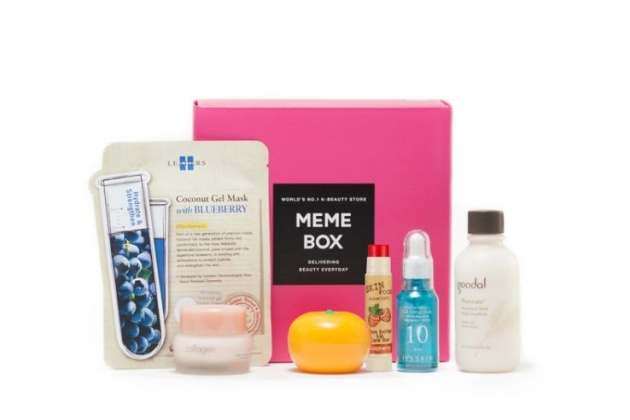
For many people around the world, their exposure to Korean pop culture is still limited to the aural and visual wonders of Psy’s “Gangnam Style” video. In much of Asia, however, the demand for Korean entertainment and products is so strong that it even has a special term in Chinese and Japanese that means the “Korean Wave.” Beauty products are a breakout export and Memebox, a Seoul-based e-commerce startup riding that surf, has just closed a $17.5 million Series B. Combined with its previously unannounced Series A, this brings the total Memebox has raised to $29.35 million.
Investors include Formation 8, Goodwater Capital, AME Cloud Ventures, Pejman Mar Ventures, Y Combinator (Memebox took place in its accelerator program last year and was selected as one of its cohort’s top three startups) , Winklevoss Capital, FundersClub, Cowboy Ventures, and Altos Ventures.
Founder Dino Ha, who previously worked for designer Tom Ford before moving on to South Korea’s Ticket Monster, tells TechCrunch that Memebox will use the capital to build its operations in South Korea, the U.S., and China, its newest market. In addition to upgrading its mobile apps, which currently account for 80 percent of its transactions, Memebox will also expand its private cosmetics and skin care label, and improve its logistics network.
Bringing “K-Beauty” To The World
Memebox differs from other beauty box services like Birchbox by focusing on Korean brands and not offering a subscription service (boxes of products are centered around a theme, like winter skin care, and sold individually). Furthermore, beauty boxes now account for less than five percent of Memebox’s total business, with the bulk coming from its e-commerce store and private label.
“Korea has become one of the best countries for manufacturing cosmetics,” Ha says. “We have two public companies called Cosmax and Kolmar that are world-class manufacturers. Their clients include L’Oreal and the quality of their products is finally paying off as we see Korean beauty being taken to a global level.”
The startup uses data gathered from search queries on e-commerce store and apps, sales, customer feedback, and social networks to create products for its own brand.
“It’s not a highly sophisticated technology, but I think it’s something that is unique in that we are specifically trying it for the beauty industry,” says Ha.
“If consumers are looking for pink this season, once we tell brands, it usually takes about 15 months for them to come out with another color, so you have to wait more than a year to see the product. Our private label is vertically integrated with software. When consumers look for a specific product, we make sure it’s uploaded to our store within a two month period.”
Memebox markets its own products with popular YouTube “beauty gurus,” or vloggers who upload makeup tutorials and reviews. One partnership is with Pony, the top-rated YouTube makeup channel in South Korea. Ha says that Pony x Memebox’s test run last December sold out of 25,000 units in 40 minutes after the cosmetics launched, which convinced the startup to continue pursuing collaborations.
One of the things that has helped Korean beauty brands gain fans in other countries is their rapid manufacturing cycle. Like fast fashion chains H&M and Zara, Korean cosmetic companies are quick to react to trends and have the capability to push out quality products for relatively low prices.
Sixteen of the top 30 customers on its Korean site and app were from China, even before Memebox launched localized Chinese-language versions in October. The company now has a team of 20 employees based in Shanghai.
“There are a lot of actors driving the Korean beauty trend,” says Ha. “K-Pop, Korean drama, and Korean celebrities are very active in China.”
Going From Niche To Mainstream
The item that first elevated the profile of Korean cosmetics around the world was BB cream, a combination moisturizer, sunblock, and foundation that originated in Germany, but became massively popular in South Korea and Japan. About three years ago, demand for BB creams grew strong enough that U.S. companies, including Clinique and Maybelline, began to introduce their own versions.
Another factor is the high profile of Asian and Asian American YouTube beauty bloggers, who often review or promote Korean beauty products.
Ha says that more than 60 percent of Memebox’s U.S. customers are Caucasian people, many of whom became interested in Korean cosmetics and skin care after their Asian American friends introduced them to brands.
Despite its growing popularity, Korean beauty is still considered a niche category outside of Asia. The company currently has 24,000 active customers in the U.S., mostly makeup artists or fans obsessed with trying new products.
“There are 1,800 Korean beauty brands and less than 200 can be found in the U.S. We are partnered with a 1,000 beauty brands now, but we still have not brought the other 800 to the market,” says Ha.
Ha hopes that Memebox’s private label and its collaboration with influential YouTube vloggers, as well as a partnership with Nylon magazine, will help it gain more attention, first among makeup and fashion aficionados who quick to jump on new trends before filtering onto mainstream consumers. There are signs that is already happening: the popular beauty chain store Sephora has started carrying more Korean imports.
Working at Ticket Monster taught Ha the basics of e-commerce, while his experience at Tom Ford showed him the importance of design in building a brand. He says that Memebox is a mobile shopping company that happens to focus on the beauty industry (it plans to launch 10 new apps soon). Another thing that sets the startup apart is its focus on building its own logistics center in all of its markets instead of relying on third-party providers.
“One of our pillars is vertical integration. We don’t outsource anything. In Korea, we have a 1,500 square foot logistics center that we run,” says Ha. “We’re selling beauty products, so these consumers are very sophisticated and we want to make sure the customer experience is better than other shopping sites.”



